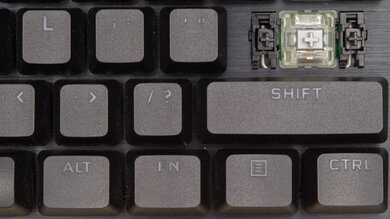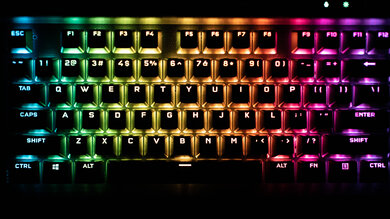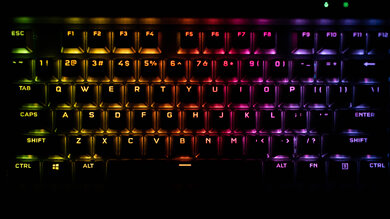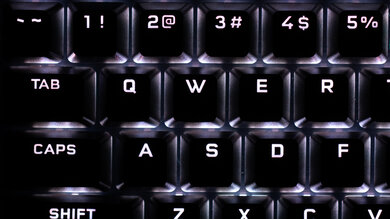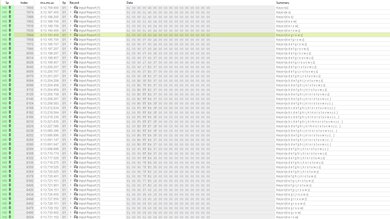The Corsair K70 RGB TKL is a fantastic gaming keyboard that's a smaller 80% version of the Corsair K70 RGB MK.2. It's a well-built model that comes with solid doubleshot PBT keycaps. It has a ton of gaming features, like macro-programmable keys, full RGB backlighting, and there's a 'Tournament Mode' switch that disables all macros and displays a single color so you can focus on gaming. Our unit has Cherry MX Speed switches, which are very light to press for a responsive gaming experience, and it's also available with linear Cherry MX Reds or Corsair OPX optical switches. If you want to use it for the office and don't mind the sensitive switches, it has great albeit loud typing quality.
Our Verdict
The Corsair K70 RGB TKL is a fantastic gaming keyboard. The Cherry MX Speed switches on our unit are very light to press with minimal pre-travel distance. Its latency is also very low for a responsive gaming experience. All keys are macro-programmable, it has full RGB lighting, and it's very well-made. Sadly, it doesn't come with a wrist rest for those long gaming sessions.
- Keys are very light to press.
Clear and bright full RGB backlighting.
- All keys are macro-programmable.
- Very well-built.
Superb latency performance.
Up to 8000Hz polling-rate.
- No included wrist rest.
The Corsair K70 RGB TKL is good for office use. It's very well-made, and the doubleshot PBT keycaps feel great. It has great typing quality, but the linear Cherry MX Speed switches don't have any tactile feedback and can cause more typos than usual. Unfortunately, it doesn't come with a wrist rest, which may be disappointing to some.
- Very well-built.
- Great typing quality.
Keys are relatively quiet and shouldn't bother people around you.
- No included wrist rest.
- Keys may feel too sensitive for some.
The Corsair K70 RGB TKL is wired-only and can't be used with mobile devices.
The Corsair K70 RGB TKL is very good for programming. You can set macros to any key, and it has full RGB backlighting. The typing quality is great, but the linear switches can be too light to press for some, which can cause an increase in typos. It's very well-made with a solid frame, but it doesn't come with a wrist rest.
Clear and bright full RGB backlighting.
- All keys are macro-programmable.
- Very well-built.
- No included wrist rest.
- Keys may feel too sensitive for some.
The Corsair K70 RGB TKL is disappointing for home theater PC use. Since it's wired-only, you have to connect it directly to the TV and sit within its cable range. It also lacks a trackpad, so you'll need a mouse to navigate the user interface. However, it has full RGB backlighting, so you can see the keys in the dark, and it has dedicated media keys.
Clear and bright full RGB backlighting.
- Dedicated media keys.
- Wired-only.
- No trackpad.
The Corsair K70 RGB TKL is outstanding for competitive gaming. Its switches are lightweight and feel responsive, and it supports a 4000Hz effective update rate that helps deliver very low and consistent single-key and multi-key latency. Its chord split performance is also great, which makes it completely suitable for rhythm games or any title that demands multiple simultaneous inputs.
Superb latency performance.
Up to 8000Hz polling-rate.
Changelog
-
Updated Jul 11, 2025:
We added new details throughout the review concerning the version of this keyboard with Corsair OPX optical switches, notably in the Differences Between Variants section.
- Updated Nov 29, 2023: We've converted this review to Test Bench 1.3.1, which adds a new estimated PCB latency test to the Single-Key Latency section and a new Analog test to the Switches section of this review. You can see the full changelog here.
- Updated Oct 27, 2023: We've converted this review to Test Bench 1.3, which overhauls how key input is evaluated. We've added new tests for Single Key Latency, Multi Key Latency, Data Transmission, and Chord Split. We've also introduced a new Raw Performance usage and adjusted how the Gaming and Office usage scores are calculated. You can see the full changelog here.
- Updated Jun 12, 2023: We've converted this review to Test Bench 1.2. This update introduces new Backlight Features and Backlight Clarity test boxes. We've also added a new Switches test box, added additional test comparisons to our Hardware Customizability test box that we introduced with our last Test Bench. For an in-depth look at our changes, you can see our full changelog here.
Check Price
Differences Between Sizes And Variants
We tested the Corsair K70 RGB TKL with Cherry MX Speed switches, and it's also available with Cherry MX Red switches and Corsair OPX switches. The Corsair OPX switches don't offer any meaningful latency advantage over the MX Speed switches we tested. However, they use a contactless optical design to register keystrokes, which can make them significantly more durable, since they aren't prone to contact wear or corrosion like traditional mechanical switches.
If you have the Corsair K70 RGB TKL and notice it's different from ours, let us know, and we'll update the review. You can see the label for our unit here.
Popular Keyboard Comparisons
The Corsair K70 RGB TKL is a fantastic gaming keyboard that challenges its competition in terms of gaming performance. It's very well-built, has a ton of features, and the linear Cherry MX Speed switches are light to press. Those looking for a more versatile keyboard may be a bit disappointed with the lack of wrist rest and switch variety, but it should please most gamers.
Also see our recommendations for the best gaming keyboards, the best Corsair keyboards, and the best keyboards for programming.
The Corsair K70 RGB TKL and Corsair K70 PRO TKL are tenkeyless gaming keyboards from the same lineup, offering similar raw gaming performance. The main difference is that the K70 RGB TKL uses conventional mechanical or optical switches, while the K70 PRO TKL features Hall effect switches, enabling per-key actuation and reset point adjustments. There are also some minor design distinctions—the K70 RGB TKL includes a full set of dedicated media keys and a volume roller but lacks a wrist rest, whereas the K70 PRO TKL primarily uses a button and rotary dial for media control and comes with a wrist rest.
The Corsair K70 RGB TKL and the Corsair K70 RGB PRO are both wired, mechanical gaming keyboards that perform very similarly with some slight differences. The RGB TKL is a smaller form factor, so it doesn't have a Numpad. Also, its latency is somewhat lower than the RGB PRO. On the other hand, the RGB PRO allows you to program macros directly onboard without using the software, and it includes a wrist rest. Both keyboards have a Tournament Switch to create a distraction-free gaming experience, and they also have an 8000Hz maximum polling rate.
The HyperX Alloy Origins and the Corsair K70 RGB TKL are both fantastic gaming keyboards. The HyperX is available with linear, tactile, and clicky switches, so you can get the type you prefer, while the Corsair is only available with linear switches. Since the HyperX is bigger, it has a numpad, but the Corsair has dedicated media keys, which the HyperX doesn't have. Even though the Corsair has PBT keycaps, typing feels better on the HyperX because the keys aren't as sensitive as those on the Corsair.
The Corsair K70 RGB TKL and the HyperX Alloy Origins 65 are both wired mechanical keyboard designed for gaming, but the Corsair performs slightly better. It has better latency, dedicated media keys, and its companion software is available on macOS. Alternatively, the HyperX feels better built thanks to its metal chassis and baseplate. Also, its smaller than the Corsair, leaving you more room for mouse movements on your desk.
Test Results

Even for a TKL keyboard with dedicated media keys, the Corsair K70 RGB TKL is fairly compact and won't take up too much space on your desk. However, if you want a version of this keyboard that takes up even less space, check out the Corsair K70 PRO MINI WIRELESS.
The Corsair K70 RGB TKL has excellent build quality. It has a hard plastic body that shows no signs of flex, and there's an aluminum plate on top, but it feels sharp at the edges. The doubleshot PBT keycaps are advertised to be 1.5 mm thick, and they feel very solid and thicker than most keycaps. They also feel resistant to wear or oil shine. It comes with extra caps with different shapes or textures, but those are ABS plastic. All keys feel stable; only the spacebar has a bit more wobble than other keys, but it's not too bad. There are rubber feet on the bottom that hold the keyboard in place during regular use, so it doesn't slide around easily. Overall, it's a premium and well-built keyboard without any obvious quality control issues.
The Corsair K70 RGB TKL is a basic straight keyboard with one incline setting, but there's no wrist rest included like with the Corsair K70 RGB MK.2. However, the incline is low enough that it doesn't put too much strain on the wrists, and you shouldn't feel too tired using it for long periods.
The Corsair K70 RGB TKL comes with a braided USB-A to USB-C cable.
The Corsair K70 RGB TKL is a wired-only keyboard that can't be used with mobile devices.
The Corsair K70 RGB TKL has a few extra features to improve the user experience. There's a Windows key lock, which you can reprogram to disable other functions. All keys are macro-programmable, and you must record macros through the dedicated software. There's a 'Tournament Mode' switch on the top side next to the USB-C input, and when activated, it disables all macros and displays a single static color. You can change which color it displays. Lastly, its polling rate can be set to 125Hz, 250Hz, 500Hz, 1000Hz, 2000Hz, 4000Hz, or 8000Hz.
The Corsair K70 RGB TKL offers great typing quality. The PBT keycaps feel great to touch, and the keys are well-spaced out so they don't feel cramped. They're also stable, and even though the spacebar is a bit wobbly, it's not too bad. The keys are very light to press, so you shouldn't get tired while typing, but that can also cause more typos because they actuate so easily. Overall, you can tell it's designed for a quick gaming experience, but once you get used to the linear feel of the switches, it feels great to type on this keyboard. If you're interested in a similar keyboard with a more versatile typing experience, check out the SteelSeries Apex 9, as you can choose between two preset actuation point settings: one that's suited for gaming and one that's better for typing.
The Cherry MX Speed switches on our unit are relatively quiet and shouldn't bother those around you. We also expect the Cherry MX Red and Corsair OPX switches to be around the same noise levels.
Our unit of the Corsair K70 RGB TKL has Cherry MX Speed switches. It's also available with linear Cherry MX Red switches or Corsair OPX optical switches.
The Corsair OPX switches don't offer a meaningful latency advantage over the other switches we tested, but they use a contactless optical design to register keystrokes. This can make them significantly more durable, as they aren’t susceptible to contact wear or corrosion like traditional mechanical switches.
The Cherry MX Speed switches on the unit we bought and tested have very low pre-travel distance and are light to press. However, we noticed that the switches don't feel completely linear like those on the Corsair K95 PLATINUM because there's a tactile event before the actuation point, similar to tactile switches, but this shouldn't be noticeable for most people. If you're interested in a similar high-performance gaming keyboard that has a hot-swappable PCB so you can use whichever switches you prefer, check out the Ducky One 3.
The Corsair K70 RGB TKL has extremely low latency. We tested it with the polling rate to be set to 8000Hz, and we don't expect there to be a significant increase in latency at settings of 1000Hz and above.
Multi-key latency is also superb, making this keyboard well-suited for playing any game that requires additional keystrokes while multiple keys are pressed and maintained
This keyboard offers impressive chord split performance, with very low delay when pressing four or eight keys at once. It's a great choice for rhythm games or any title that demands multiple simultaneous inputs.
Corsair's iCUE software is a user-friendly program that's available for both Windows and macOS. You can set macros, customize RGB lighting, and set the polling rate. The keyboard has onboard memory, so you can easily carry over your macros and settings to a computer that doesn't have the program installed.
The Corsair K70 RGB TKL is only fully compatible with Windows; on Linux, every key works, but the software isn't available. On macOS, the Stop, Scroll Lock, and Pause/Break buttons don't do anything. Also, F11 minimizes windows, Print Screen functions as F13, and the volume wheel controls the system volume and not the iTunes volume.




